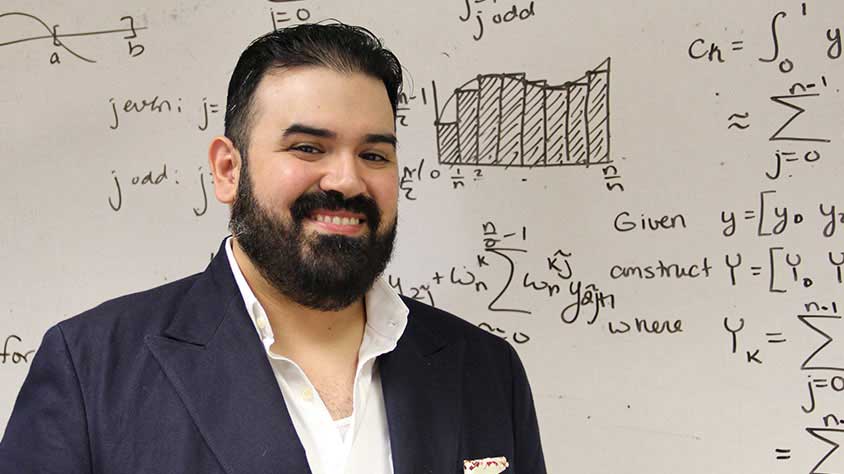Think of it as a Valentine to mathematics.
“The rate of Romeo’s love is proportional to the amount of Juliet’s affection, and Juliet’s rate of change in affection is negatively proportional to Romeo’s.”
That’s one way to understand and appreciate Shakespeare, love and math. The speaker, Josef Sifuentes, knows something about each, and in time for St. Valentine’s Day this year he made a video translating the love story at the heart of Romeo and Juliet into a mathematical model.
“It’s tongue-in-cheek, of course, but the differential equations are mathematically correct. My motive was to illustrate that math isn’t just abstract and foreign to our lives. It has real-life applications and it can help us understand how the world works,” said Sifuentes, who earned three degrees at Rice University, including a Ph.D. in computational and applied mathematics in 2010.
Since 2015, he has been an assistant professor in the School of Mathematical and Statistical Sciences at the University of Texas Rio Grande Valley (UTRGV). The Edinburg campus is a half-hour’s drive from the U.S./Mexico border, and 90 percent of its students are Hispanic.
Sifuentes, 37, was born and raised in Houston, in Magnolia Park, a predominantly Hispanic neighborhood in the East End. His father, Jesse Sifuentes, a former high-school teacher, is an artist whose work includes several public murals around the city. His mother, Lena Sifuentes, works as the accountant and financial analyst for the computer science department at Rice.
As a teenager, math and art vied for Sifuentes’ affections, and his B.A. from Rice is in mathematics, computational and applied mathematics (CAAM), and visual arts. “The only aspect of engineering I really liked at first was math. It was Richard Tapia who told me I could do math and art, that there was no contradiction there,” he said.
After Sifuentes’ freshman year, Tapia, University Professor at Rice and much-honored professor of CAAM, asked him to make a video about the 1970 Chevrolet Chevelle Super Sport that he took to car shows. “The video is garnished with other scenes that tie in with the mood a 1970 muscle car moving through flames would create. It’s called ‘Heavy Metal,’” Sifuentes said.
His interests coalesced. For the “Heavy Metal” video he received the James Waters Award for Creativity in Engineering in 2004. Starting that year he traveled the country with a multimedia production called “Heavy Metal: Fusing Art and Mathematics through Cars,” as part of Tapia’s series “Math Is Cool.” “We gave this talk to dozens of audiences, from K-12 through Ph.D.’s. The idea was to demonstrate the beauty of mathematics,” he said.
In 2006 he was awarded a National Science Foundation Graduate Research Fellowship. His research focus today is numerical linear algebra, with an emphasis on iterative methods for nonsymmetric linear systems. He has developed computational modeling of acoustic and electromagnetic wave scattering, with applications in medical and seismic imaging, radar, sonar, remote sensing and lasers.
For two years beginning in 2010, Sifuentes worked as a research scientist at the Courant Institute of Mathematical sciences at New York University, and for another three years he was a visiting assistant professor at Texas A&M.
Sifuentes and his wife, Maribel, have two children: Sofia, 7, and Aaron, almost 2. Maribel, a program manager at the Brownsville campus of the University of Texas Health Science Center School of Public Health, runs a diabetes management initiative. She earned a B.S. in kinesiology and Hispanic studies from Rice in 2004.
“I’m doing interesting work but my wife is saving lives,” he said. “It’s all about family. When I look back now, I realize my parents were really instrumental in what I do.”

